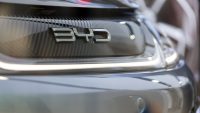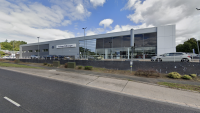LIKE most of those involved in the previously cherished motor carriage relocation industry, I am rather looking forward to spring this year.
It may have been one of the milder winters of the past few years, but for some reason I’ve also found it one of the darkest.
 Whether there’s a specific reason for that, like it always being cloudy on days with a full moon, or whether it’s just down to that pestilential man off the BBC News delivering yet more made-up guff dressed up as economic doom and gloom I don’t know, but I, for one, will be glad to see the back of the short days and long evenings.
Whether there’s a specific reason for that, like it always being cloudy on days with a full moon, or whether it’s just down to that pestilential man off the BBC News delivering yet more made-up guff dressed up as economic doom and gloom I don’t know, but I, for one, will be glad to see the back of the short days and long evenings.
By the time you read this, the days will be getting that little bit longer – there’s an Equinox of some sort going on, but not being somebody who avoids personal hygiene, eats flowers and smokes weed, I don’t know whether its vernal, northward, southern or vegetable.
What I do know is it means the clocks will go forward. And that, you might think, is the only time you’ll ever find a car dealer winding the clocks forward.
But you’d be wrong. And to tell you why, I’ll wind the clock back – to 1992.
Back then, a thirty-something car dealer who wishes to remain anonymous, so for the purposes of this column we’ll call him Michael Bigg, worked for a small independent sales site on the outskirts of Birmingham.
His boss was rather matey with a couple of lads who worked up at the Rover plant in Longbridge, which often proved useful when we needed parts for stock vehicles that were small enough to fit in his lunchbox.
Indeed, even now, it’s a standing joke around these parts that the designers changed the size of the clutch plate in a Metro in order that it might fit more neatly between two slices of bread.
Anyway, I digress. One day in the summer of ’92, the aforementioned Mr Bigg turned up at work to find not just one, but seven G-plated Montegos jostling for position on the forecourt, all finished in delightful shades of beige, white or ready-faded red.
Rover’s Cavalier-rival was a tricky enough beast to sell at the best of times (there’s a reason RAC patrols used to call the hard shoulder of the M6 ‘Montego Bay’, after all), but to find seven of them, all in solid colours in miserly ‘L’ spec lined up on the forecourt showed that Mr Bigg’s boss was clearly unsound of mind.
On closer inspection, he noticed that each car, despite being at least two years old, still had plastic wrapping on the seat covers and those knobbly furry bits on the tyres that have all but disappeared from today’s modern, injection-moulded rubber.
 The highest mileage on any of them was 000,007 – mechanically, a Montego would easily beat the magic 100k providing you never left it out in the rain. (It was the soluble bodywork that was the Monte’s downfall, so the six-figure odometer was a tad optimistic.)
The highest mileage on any of them was 000,007 – mechanically, a Montego would easily beat the magic 100k providing you never left it out in the rain. (It was the soluble bodywork that was the Monte’s downfall, so the six-figure odometer was a tad optimistic.)
The two-year-old motors arrived on the lot thanks to a tip-off from the boss’s mate at Rover – they were cars that had been pre-registered by the company to go on the employee car scheme, but had been so unpopular following the launch of the acceptably decent Rover 200 and 400 the same year that they hadn’t even been able to foist them off on the caretaker.
Instead, matey boy had offered them out to the trade at a price too difficult to refuse. Either that, or he’d upgraded to a bloody big lunchbox. The problem was, who’d want to buy a two-year-old car that, quite clearly, had been sitting in a field and had never turned a wheel?
And so it was that Michael Bigg was forced by his boss to clock not one, but seven cars that August.
But instead of the traditional ‘haircut’, the trick was to advance to odometers to between seven and 12,000 miles – while for the next month or so he also had free transport home every night, providing he (in the words of his boss) ‘spanked the arse off it to put a bit of wear on the tyres’.
And that, my friends, is a story I remember every time I put the clocks forward in my house.
Enjoy the longer evenings!































